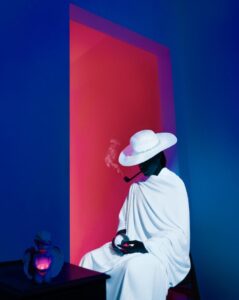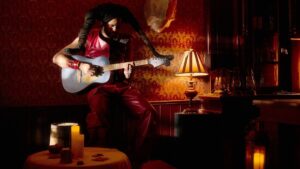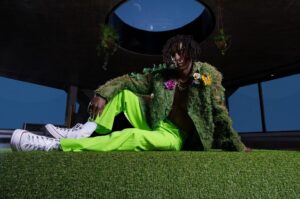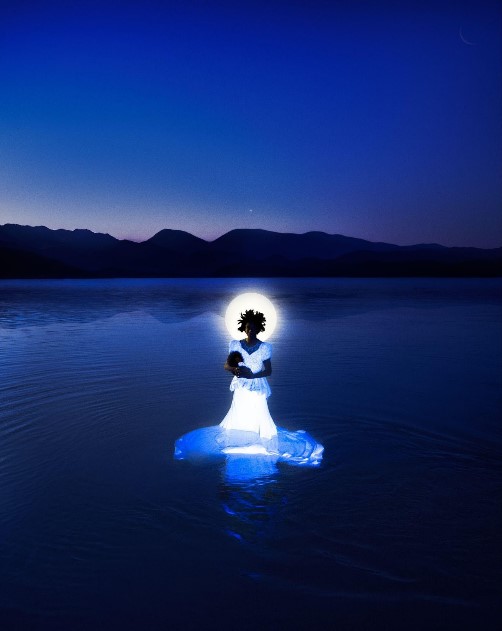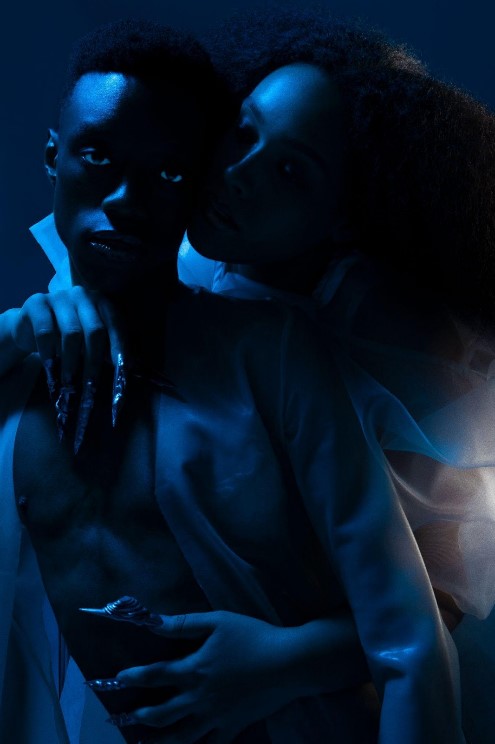
His work joins a lineage of Afro-surrealist artists who re-explore the photograph as a space of possibility, resistance and speculation. By doing so, he reminds his audience that folklore and myth are not just elements of the past but also living forces that shape identities and envision futures.
Yannis Davy Guibinga about the photoworks of Vladim Vilain.
On Folklore, Myth-Making, and Photography: The Work of Vladim Vilain
Originally from Haiti, but now based in Montreal, Canada, photographer Vladim Vilain creates visual universes where folklore, spirituality and mythology all converge in surreal and fantastical forms. Rooted in Afro-surrealism and Haitian Vodou traditions, Vilain’s work reimagines photographs as a site where visual narratives are preserved, reimagined but also expanded into new cultural mythologies. For the artist, image-making becomes a language for storytelling that bridges tradition with contemporary aesthetics in order to fight against the flattening gaze often imposed on Caribbean visual culture.
Since its inception, the expectation of a photograph has always been to depict the truth. Specifically in a Caribbean context, photographs have historically served as colonial tools of exoticization and classification. Vilain pushes against these historical confines by imagining, framing and creating portraits that pay homage to the folklore of his native country while speculating on the future simultaneously. In his photographs, it seems that there is an interest in what could be rather than what is and a consistent exploration of the myths and stories that shape identity across generations.
Tous Saint (Fleurs d’Insomnie) 2023, Photography, 24×30
Papa Legba and the Mythical Toussaint
Papa Legba is the guardian of crossroads, oscillating between the spiritual and human word in the Haitian Vodou mythology. As leader of the Haitian Revolution, Toussaint Louverture once named himself after Legba to symbolically align himself with this figure of transition and transformation. As no definitive likeness or surviving portraits of Louverture exists, Vilain creates in this image his own interpretation of the mythical figure by drawing inspiration on its connection with Legba.
The artist acknowledges the power of photography as a myth-making tool by doing so and the result is an image that is both historical and speculative as it honors the revolutionary’s legacy while simultaneously reminding the viewers that cultural memory often exceeds the limits of representation.
Bossou, 2025, Photography
Bossou, the Musician
For the Untold Cowboy project, Vilain reimagined the archetype of the saloon cowboy with a Haitian twist. Rather than exploring it through the usual Western images, the artist opted to represent the cowboy through Bossou, a Iwa symbolized by the bull in Haitian Vodou. Through the musician photographed, Vilain translates Bossou’s representation of rhythm, endurance and quiet strength visually. The result merges two archetypes, American and Haitian, into a newer figure. In that way, Vilain inserts Haitian folklore and spirituality into a narrative in which it has mostly been absent, thus expanding the frame of both the cowboy’s mythology as well as photography’s role in reimagining it.
Zaka (3003: Futura Flora), 2022
Kouzen Zaka and the Year 3003
In “Kouzen Zaka and the Year 3003” the artist imagines a future when climate catastrophe has left the world unrecognizable. In this dystopian future, the weeds and grass that were once ignored become luxury materials for garments. Inspired by Kouzen Zaka the Iwa of agriculture, fields and peasantry, Vilain creates a world where nature itself becomes a commodity that embodies the tension between destruction and renewal. By blurring dystopia and ecological reverence, the photographs point to how folklore and myth can serve as critical tools to address issues like ecological collapse. As a spirit tied to the dignity of working the land, Kouzen Zaka becomes a lens through which the artist critiques nature’s exploitation by capitalism and imagines an alternative rooted in care, reciprocity and survival.
Black Madonna III (Fleurs d’Insomnie), 2023
Erzulie Dantò and Maternal Strength
Black Madonna III explores the intersection between spiritual and personal portraiture by merging the Iwa of protection, strength and fierce maternal love Erzulie Dantò with a portrait of his own mother. The image connects spirituality with familial intimacy by collapsing personal lineage and divine archetype together. This image shows Vilain’s ability to hold multiple layers at once in his photographs. Here, photography is layered by love, culture and ancestry and becomes a shrine in which his mother is situated within a larger context of ancestral and spiritual protection.
BANDA, 2022, Photography, 13×19
Recurring Dreams: Grann Brigit and Bawon Samdi
The exploration of dreams in Vilain’s work is rooted in Vodou traditions as well. In his series BANDA he uses Grann Brigit and Bawon Samdi, spirits of the gede family celebrated on the day of the dead who travel from one world to another through the portals of these dreams. In this series, their playful nature comes alive, inspired by the Banda: a dance that mimics sexual intercourse. In this work, Vilain reminds his audience that folklore is as joyous and transgressive as it is solemn and reverent. By providing a visual reference for this erotic energy, the artist pushes against the conservative representations of spirituality in order to embrace its full and complex humanity.
Toward New Mythologies
The coherence in Vilain’s different works manifests as a commitment to re-situating photography within the domain of myth and folklore. He uses photography as portals and spaces where spirits, past and futures coexist. By aligning his image-making process with the Vodou traditions he grew up hearing about, he asserts a decolonial approach that fights against the reduction of Caribbean culture to an exotic and stereotypical spectacle and focuses on the richness and depth of his culture instead.
As photography can often feel like a medium weighed down by Western conventions of representation and what they consider truth for diasporic artists, Vilain attempts to offer an alternative of images as living myths able to preserve cultural specificity while engaging global audiences. His work joins a lineage of Afro-surrealist artists who re-explore the photograph as a space of possibility, resistance and speculation. By doing so, he reminds his audience that folklore and myth are not just elements of the past but also living forces that shape identities and envision futures.
Copyright: the artist

